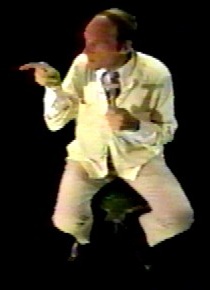Информация об исполнителе
Jerry Hunt, well-known composer of interactive computer music and intermedia works, as well as an extraordinary performer, died in November of 1993 at his home near Canton, Texas. Hunt was born in Waco, Texas in 1943 and studied piano and composition at the University of North Texas (then North Texas State University). He developed into an accomplished pianist, performing widely his own and other contemporary works by American and European composers. But it was as a general solo performer: speaking, playing keyboards, banging on suitcases, making obscure adjustments to various computers, racing back and forth across the stage with strangely lit objects in hand, ritualistically presenting to the audience homemade icons, or continually gesturing -- becoming in the process a modern-day shaman conjuring spirits -- that the brilliant and original magic of his work became stunningly apparent. To have witnessed a Hunt performance was thrilling, and to have seen him on a "good" night was to overhaul one's ideas about music and performance.
His compositions display a number of interests: including theatrical/ritual work, visual images, and computer-assisted mathematical techniques. Hunt's pieces are grouped into families related by central, generating concepts and processes. These "cores" formed the bases for a number of "derivatives and transformations". For example, a 1972 commission from the Scottish Arts Council and the British Computing Society resulted in the use of a process called "Haramand Plane: parallel/regenerative" which was the source for the Cantegral Segment(s) series (1973-1978).
Hunt worked as a composer for video and film production companies and as technical consultant for audio and video instrumentation companies. He was artist-in-residence at the Video Research Center in Dallas from 1974-77, and in recent years he devoted himself full-time to fulfilling commissions and working on collaborative projects with such people as visual artist Maria Blondeel (Gent), performance artist Karen Finley (New York), and composer and software designer Joel Ryan (Amsterdam).
His work with Finley brought him into conflict with the National Endowment for the Arts (USA) and resulted in him becoming one of a number of litigants in a law suit against the then Director of the agency.
While I have not encountered aural recordings of Hunt's work that fully convey the power of his live performances, nevertheless, one can enjoy the humor and mysterious beauty of his music via, as Hunt said, "...records determined as fixed streams devised for the repeat identic listening action which multiple reproduction allows.
http://en.wikipedia.org/wiki/Jerry_Hunt
http://www.jerryhunt.org
http://www.jerryhunt.org/recworks.htm
http://www4.ncsu.edu/~waschka/hunt.html
His compositions display a number of interests: including theatrical/ritual work, visual images, and computer-assisted mathematical techniques. Hunt's pieces are grouped into families related by central, generating concepts and processes. These "cores" formed the bases for a number of "derivatives and transformations". For example, a 1972 commission from the Scottish Arts Council and the British Computing Society resulted in the use of a process called "Haramand Plane: parallel/regenerative" which was the source for the Cantegral Segment(s) series (1973-1978).
Hunt worked as a composer for video and film production companies and as technical consultant for audio and video instrumentation companies. He was artist-in-residence at the Video Research Center in Dallas from 1974-77, and in recent years he devoted himself full-time to fulfilling commissions and working on collaborative projects with such people as visual artist Maria Blondeel (Gent), performance artist Karen Finley (New York), and composer and software designer Joel Ryan (Amsterdam).
His work with Finley brought him into conflict with the National Endowment for the Arts (USA) and resulted in him becoming one of a number of litigants in a law suit against the then Director of the agency.
While I have not encountered aural recordings of Hunt's work that fully convey the power of his live performances, nevertheless, one can enjoy the humor and mysterious beauty of his music via, as Hunt said, "...records determined as fixed streams devised for the repeat identic listening action which multiple reproduction allows.
http://en.wikipedia.org/wiki/Jerry_Hunt
http://www.jerryhunt.org
http://www.jerryhunt.org/recworks.htm
http://www4.ncsu.edu/~waschka/hunt.html
показывать / спрятать больше







 |
|



![Jerry Hunt featuring Karen Finley, Shelley Hirsch & Mike Patton - Song Drapes (1999) [FLAC (tracks + .cue)] Jerry Hunt featuring Karen Finley, Shelley Hirsch & Mike Patton - Song Drapes (1999) [FLAC (tracks + .cue)]](cache/thumbnail42/browse139580.jpg)
